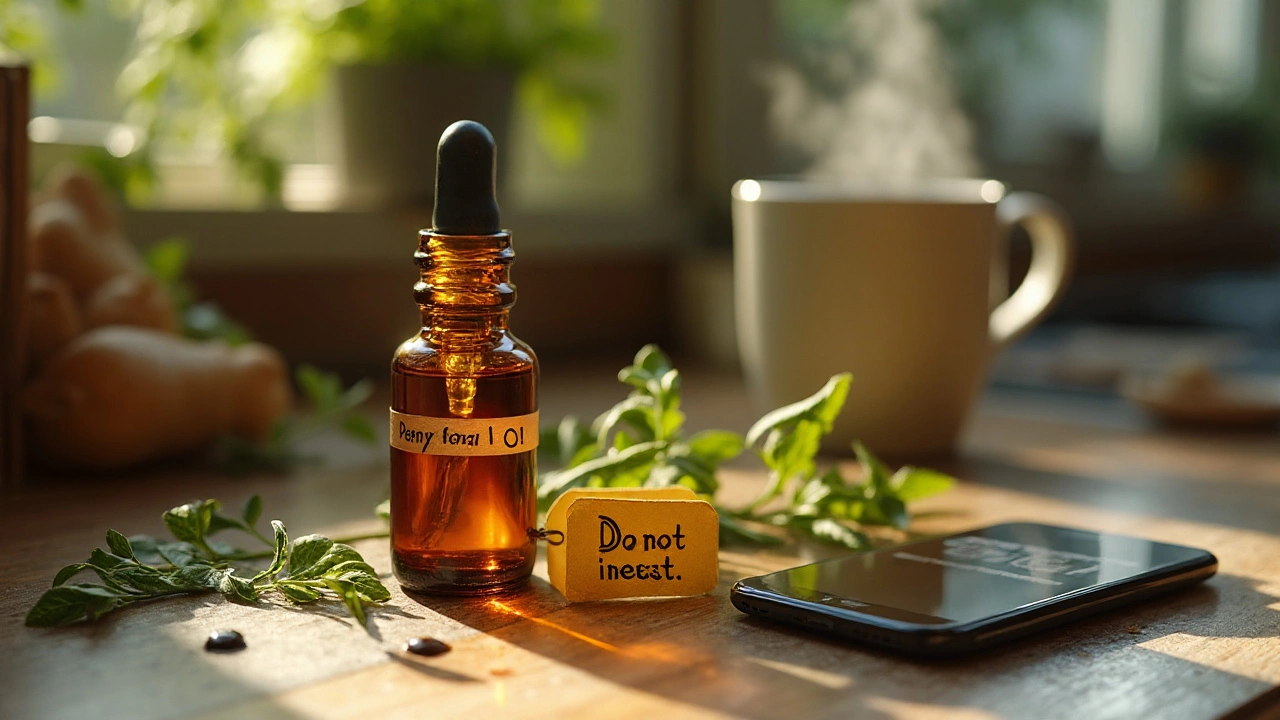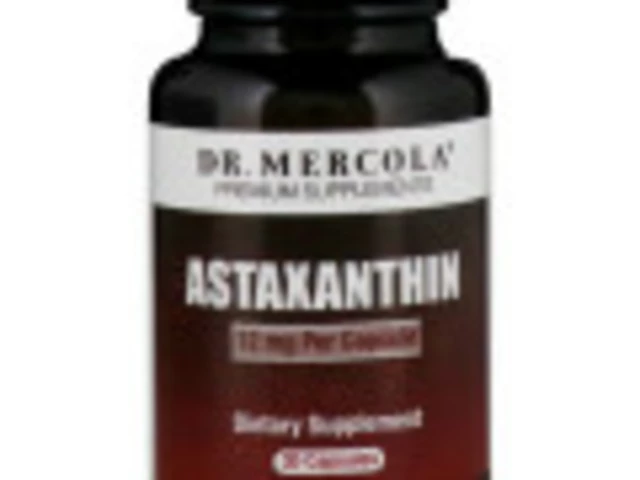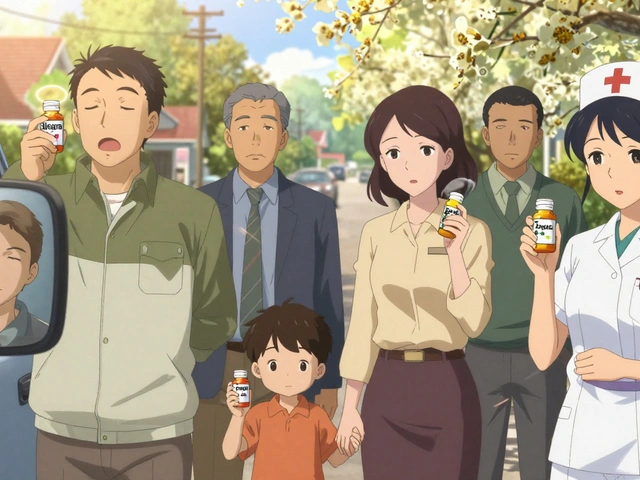You came here expecting the best reasons to start taking pennyroyal. Here’s the uncomfortable truth: there aren’t safe reasons. As of 2025, no credible medical body recommends pennyroyal as a dietary supplement. The oil can cause liver failure and seizures, and even the tea isn’t risk-free. If your real goal is calmer digestion, easier periods, better sleep, or natural bug protection, this guide shows the science, the risks, and safer options that actually help.
- Pennyroyal has no proven health benefits and well-documented toxicity (especially the essential oil). Fatal cases are in the medical literature.
- High-risk groups include anyone pregnant or trying to conceive, kids, people with liver disease, and those taking acetaminophen or hepatotoxic drugs.
- Common goals (bloating, cramps, stress, bugs) have safer, evidence-backed options like peppermint, ginger, lemon balm, and EPA-registered repellents.
- As of 2025, U.S. health agencies and poison control centers warn against ingestion of pennyroyal oil; pulegone (its main toxin) is on California’s Prop 65 list.
- If you’ve taken pennyroyal oil, don’t wait on symptoms-call Poison Control. If you drank pennyroyal tea, monitor closely and seek medical advice if you feel unwell.
What You Came For: Are There Any Safe Reasons to Take Pennyroyal?
Short answer: no. The marketing pitch for pennyroyal leans on tradition-“old-school digestive tea,” “natural balm for menstrual cramps,” or “herbal calm.” Tradition doesn’t equal safety or efficacy. When scientists look for clinical trials that show clear benefits, they don’t find them. What they do find are toxicology reports.
Let’s separate forms, because that’s where people get misled:
- Essential oil (undiluted or in capsules): this is the highest-risk exposure. Even small volumes have caused seizures and liver failure in adults. Several fatal cases in pregnant women have been documented in peer-reviewed case reports.
- Concentrated extracts and tinctures: risk varies with pulegone content, which can be high and inconsistent. Labels rarely tell you exact pulegone amounts.
- Herbal tea from leaves: lower potency than the oil, but “lower” isn’t “safe.” If the tea is strong or repeatedly consumed, risk increases. Tea is not recommended in pregnancy or for kids.
If you’re considering a pennyroyal supplement for digestion or cramps, the better move is to target the actual problem (gastric spasm, inflammation, anxiety) with herbs or medicines that have stronger safety profiles and some credible evidence.
The Science and Safety: Toxicity, Interactions, and 2025 Regulations
Why is pennyroyal dangerous? Two main compounds do the damage: pulegone and menthofuran. They’re metabolized by the liver and can deplete glutathione (your liver’s defense), leading to acute liver injury and, in bad cases, multi-organ failure. Neurologic toxicity (confusion, agitation, seizures) can also occur.
What the evidence actually says:
- Case reports in the New England Journal of Medicine and CDC’s MMWR have documented severe liver failure and deaths after ingestion of pennyroyal oil-sometimes with volumes as low as 10-30 mL in adults.
- The American Association of Poison Control Centers has long flagged pennyroyal oil as a high-risk essential oil exposure in annual reports.
- The National Center for Complementary and Integrative Health (NCCIH) and NIH Office of Dietary Supplements advise against ingesting pennyroyal oil due to toxicity and lack of proven benefits.
- The American College of Obstetricians and Gynecologists warns against pennyroyal during pregnancy; it has been misused as an abortifacient with life-threatening outcomes.
- California’s Proposition 65 lists pulegone for cancer risk; while that’s a different concern than acute poisoning, it underscores the risk profile.
Who is at greater risk?
- Pregnant or trying to conceive: pennyroyal is contraindicated. It’s been linked to fetal toxicity and maternal hepatic failure.
- Breastfeeding: avoid; safety is not established and potential toxicity is significant.
- Children: avoid entirely. Kids are more vulnerable to essential oil toxicity.
- Liver disease or heavy alcohol use: pennyroyal can push an already stressed liver into failure.
- People taking hepatotoxic drugs or acetaminophen: pulegone may worsen liver injury by depleting glutathione, the same pathway that protects against acetaminophen toxicity.
Interactions worth knowing:
- Acetaminophen (paracetamol): increased risk of liver injury; avoid this combo completely.
- Other hepatotoxic meds (e.g., certain anti-tuberculars, methotrexate): additive risk.
- Drugs metabolized by CYP enzymes: pennyroyal can unpredictably alter metabolism; specifics vary and data are limited, which is part of the safety problem.
Regulatory landscape in 2025:
- Dietary supplements in the U.S. aren’t preapproved by the FDA. That doesn’t mean they’re safe; it means sellers can list products until there’s a safety action.
- FDA and NCCIH consumer updates have warned about pennyroyal oil toxicity for years. Reputable brands often avoid selling it for ingestion.
- Quality control is unreliable. Pulegone levels can vary wildly between batches, and labels rarely disclose actual content.
Bottom line from the science: there’s no credible, repeatable benefit to justify the well-established risks, especially from the oil or concentrated extracts.

Safer Alternatives Mapped to Your Real Goal
People don’t actually want pennyroyal; they want relief. Match the goal to safer, evidence-backed options with clearer dosing and risk profiles.
Digestive discomfort (gas, cramping, IBS-type spasm)
- Peppermint tea or enteric-coated peppermint oil: can relax gut smooth muscle and reduce spasm. Enteric-coated forms are designed to release in the intestine, not the stomach, reducing heartburn risk.
- Ginger (capsules or tea): helpful for nausea and mild dyspepsia. Often well tolerated.
- Behavioral tweaks: smaller meals, avoid trigger foods (high-fat, spicy), and don’t lie down right after eating.
Menstrual cramps
- NSAIDs (e.g., ibuprofen) at the first hint of cramping are still the gold standard for many. If you can’t take NSAIDs, ask your clinician about alternatives.
- Ginger (e.g., 500-1000 mg/day short-term) has small but decent evidence for dysmenorrhea relief.
- Heat therapy: heat wraps or a heating pad can reduce pain quickly.
- Longer-term control: discuss hormonal options with your clinician if cramps are severe or monthly.
Stress, restlessness, or sleep
- Lemon balm tea or extract: calming with a kinder safety profile than pennyroyal.
- Lavender aromatherapy: inhaled (not ingested) lavender can support relaxation; choose reputable brands and avoid direct ingestion of essential oils.
- Sleep hygiene basics: fixed wake time, dark room, no late caffeine, and a 30-60 minute wind-down routine.
Natural bug protection
- EPA-registered repellents like DEET, picaridin, or oil of lemon eucalyptus (PMD) have actual efficacy and safety data.
- Clothing strategies: permethrin-treated clothing, long sleeves, and avoiding peak hours help more than any folklore remedy.
Quick comparison
| Goal | What marketers claim for pennyroyal | Evidence profile | Safety notes | Better option |
|---|---|---|---|---|
| Gas/cramping | Soothes digestion | No solid clinical trials; historical use only | Oil can cause liver failure; tea not risk-free | Peppermint tea/enteric-coated oil; ginger |
| Menstrual cramps | Relieves pain | No convincing data | High risk in pregnancy; overall hepatotoxic | Ginger, NSAIDs, heat therapy |
| Anxiety/sleep | Calming herb | Lack of robust trials | Essential oil ingestion unsafe | Lemon balm, lavender aromatherapy |
| Insect repellent | Natural bug deterrent | Inconsistent, short-lived | Topical oil can irritate skin; systemic risk if absorbed | DEET, picaridin, oil of lemon eucalyptus |
How to Vet Any Herbal Supplement (Checklist + Decision Tree)
Use this whenever an herb shows up on your feed promising miracles.
Rapid checklist (2-minute screen)
- Safety first: Does NCCIH or NIH ODS warn against ingestion? If yes, stop there.
- Form matters: Is the product an essential oil meant for ingestion? If yes, that’s a red flag; most essential oils are not for internal use.
- Evidence check: Are there randomized controlled trials showing benefit for your goal? Not anecdotes or single animal studies.
- Quality badge: Does the bottle carry USP Verified, NSF Certified for Sport, or ConsumerLab-verified claims? If no, contamination risk is higher.
- Interactions: Will it hit your meds, liver, or kidneys? When in doubt, ask your clinician or pharmacist.
Label-reading rules of thumb
- Avoid products that hide behind “proprietary blend” without exact amounts per ingredient.
- Essential oils should not be labeled for ingestion unless you’ve verified safety with a credible source (and even then, think twice).
- Look for standardized extracts with the active constituents quantified (e.g., % menthol for peppermint), not vague “herbal complex.”
Decision tree
- What problem are you solving? Name it (e.g., cramps, bloating, sleep).
- Find two options with human data and a clear safety profile for that problem (e.g., peppermint for IBS spasm).
- Screen out anything with major toxicity warnings (pennyroyal, comfrey, kava in certain liver-risk contexts).
- Choose one product with third-party testing (USP/NSF/CL) and a single active herb, not a kitchen sink blend.
- Trial for 2-4 weeks, track symptoms, and stop if no benefit or any side effects.
Pitfalls to avoid
- “Natural = safe” bias: ricin and hemlock are natural, too.
- Assuming teas are harmless: steeping time and plant parts can concentrate toxins.
- Stacking multiple liver-metabolized herbs while taking acetaminophen. That’s how “mild” risks add up.

FAQ and Next Steps
Is pennyroyal tea safe if I don’t use the oil?
It’s lower risk than the oil but not safe, especially in pregnancy, kids, or anyone with liver issues. Cases of toxicity from strong teas exist. There are safer teas (peppermint, ginger, lemon balm) that do the job better.
Is there a safe dose of pennyroyal?
No. The toxic window is too close to the amounts people might ingest, and product potency varies. With known hepatotoxins, “safe dose” is not a meaningful concept for home use.
What about topical pennyroyal for bug bites?
Skip it. Skin can absorb it, and irritation or systemic effects are possible. Use proven repellents (DEET, picaridin, oil of lemon eucalyptus) and non-sensitizing essential oils only for aroma, not as medicine.
Do any doctors recommend pennyroyal?
No mainstream medical organization endorses pennyroyal for ingestion. NCCIH, NIH ODS, and Poison Control warn against it. Many reputable retailers refuse to sell ingestible pennyroyal products.
I already took some pennyroyal oil. What now?
If you swallowed essential oil, call Poison Control right now. Don’t wait for symptoms like nausea, vomiting, abdominal pain, dizziness, or confusion-liver injury can be delayed by 12-24 hours. Do not induce vomiting. If you made tea and feel unwell, seek medical advice, especially if pregnant or if you took acetaminophen.
Does boiling or cooking make pennyroyal safe?
No. Heat doesn’t reliably remove or inactivate pulegone or menthofuran to a safe level, and you can’t home-measure what’s left.
Is pennyroyal allowed in the U.S.?
Dietary supplement law allows many products onto the market until regulators intervene, but that doesn’t mean safe. As of 2025, health agencies caution against ingestion, and pulegone is listed under California Prop 65. Many retailers avoid it entirely.
Is it safe for pets?
No. Pennyroyal can be toxic to cats and dogs; veterinary toxicology cases exist, especially from topical flea products of the past. Keep it away from pets.
Next steps by persona
- If you’re pregnant or trying: avoid pennyroyal in any form. For nausea, consider ginger or vitamin B6, and talk to your clinician for tailored guidance.
- If you wanted digestive relief: start with peppermint tea or enteric-coated peppermint oil and basic diet tweaks. If symptoms persist, get evaluated for reflux, IBS, or food intolerance.
- If cramps brought you here: try ginger and heat therapy; use NSAIDs early if appropriate. If cycles are painful every month, ask about hormonal options.
- If stress/sleep was the hook: try lemon balm tea and a consistent sleep routine; consider CBT-I apps if insomnia lingers.
- If bugs are the issue: pick an EPA-registered repellent and pair it with permethrin-treated clothing for high-exposure trips.
When to seek care
- Any ingestion of pennyroyal essential oil.
- Symptoms within 24 hours of pennyroyal exposure: nausea, vomiting, right upper abdominal pain, yellowing eyes/skin, confusion, agitation, or seizures.
- Kids or pregnant people with any exposure.
How I’d make the call in real life
If a friend asked me in Seattle whether they should try pennyroyal for cramps or bloating, I’d say this: the risks are real, the benefits aren’t. Use what works and what’s consistently safer. Keep your liver for the long haul.
Credible sources to read next (no links, just names): NIH Office of Dietary Supplements; National Center for Complementary and Integrative Health (NCCIH) on pennyroyal and essential oils; CDC’s Morbidity and Mortality Weekly Report case summaries on pennyroyal toxicity; American Association of Poison Control Centers annual reports; American College of Obstetricians and Gynecologists on herbal use in pregnancy; California Proposition 65 listing for pulegone.












Michael Kerford
September 7, 2025 AT 02:14 AMBro just googled pennyroyal after reading this and now I’m scared to drink tea ever again. Like, what even is safe anymore? My grandma swore by it for cramps. Now I’m just gonna sit here and cry into my chamomile.
Geoff Colbourne
September 8, 2025 AT 01:17 AMOh wow so now we’re banning herbs because some guy in 1998 drank a shot of oil and died? That’s not science, that’s fearmongering. My cousin in Oregon uses pennyroyal tea every month and she’s fine. You think Big Pharma doesn’t want you to know about natural remedies? Wake up.
Daniel Taibleson
September 8, 2025 AT 11:13 AMWhile the tone of this piece is appropriately cautionary, I appreciate the structured comparison of alternatives. The evidence-based mapping of goals to safer interventions is clinically sound and aligns with current guidelines from NCCIH and ACOG. The emphasis on third-party verification (USP, NSF) is particularly valuable for consumers navigating unregulated markets.
Jamie Gassman
September 9, 2025 AT 18:11 PMLet me break this down for you: The FDA doesn’t regulate supplements because they’re in bed with Big Pharma. Pennyroyal has been used for centuries by indigenous cultures and midwives. Pulegone is on Prop 65? That’s because the state is owned by chemical corporations who sell synthetic repellents. They’re terrified you’ll realize you don’t need their $12 DEET spray when a cup of tea costs 25 cents. This isn’t about safety-it’s about control. Wake up, sheeple.
Julisa Theodore
September 10, 2025 AT 11:25 AMSo… natural = bad, chemicals = good? That’s the logic here? What’s next, banning sunlight because UV rays cause cancer? I’m not taking your DEET, I’m taking my tea. And if I die, at least I died on my own terms, not some lab-coat-approved corporate dream.
Lenard Trevino
September 12, 2025 AT 07:43 AMOkay hear me out. I’ve been researching herbal toxicity for 14 years, mostly because my aunt tried to use pennyroyal to ‘cleanse’ after a miscarriage and ended up in the ICU for 11 days. I’m not here to scare you, but I’ve seen what happens when people treat herbs like candy. The problem isn’t just the oil-it’s the culture around it. People think if it’s green and smells like earth, it’s holy. But plants don’t care if you believe in them. They just react with your liver. And your liver? It doesn’t have a voice. It just shuts down. And then you’re dead. And your Instagram post about ‘natural healing’ is still up. That’s the real tragedy.
Paul Maxben
September 13, 2025 AT 14:36 PMLOL you guys are so extra. I drank pennyroyal tea for 3 years and I’m fine. My pee smells like mint but I’m alive. You think your ‘science’ is better than my body? Nah. I got a 2024 blood test. Liver enzymes? Perfect. So eat it. I’m not scared of your charts and your NCCIH. I’m scared of your boring lives.
Molly Britt
September 14, 2025 AT 09:37 AMThey’re lying. Pennyroyal is a government weapon. The tea is safe. The oil is laced. They want you to think all of it’s dangerous so you buy their synthetics. Look up the 2023 CDC memo on ‘herbal suppression programs.’ They’re coming for your lavender too.
Nick Cd
September 15, 2025 AT 20:33 PMyou think this is about health? no its about control. the government knows pennyroyal can help with anxiety and sleep and they dont want you calm they want you anxious so you buy their pills and their therapy and their apps and their subscriptions and their supplements that cost 50 bucks a bottle. i used pennyroyal oil in my diffuser for 2 years and i never got sick. i think they just hate that its cheap and natural and people dont need them anymore. poison control is run by pharma. they made up the whole thing. i saw it on a forum. someone said it and it made sense. i cried. i felt seen.
Patricia Roberts
September 16, 2025 AT 06:12 AMOh wow, a 12-page essay on why we can’t have nice things. Next you’ll tell me that drinking water is risky because of chlorine. At this point, I’m just gonna eat dirt and call it ‘ancient wisdom.’ At least dirt doesn’t come with a 3000-word warning label.
Adrian Clark
September 16, 2025 AT 17:42 PMSo let me get this straight - you’re telling me that if I want to avoid bugs, I can’t just rub a leaf on my arm? I have to spray myself with chemical warfare? And if I want to chill out, I can’t sip tea, I need a 90-minute sleep routine and a CBT app? I’m not a robot. I’m a human who likes plants. You’re not helping. You’re just making herbalism feel like a crime.
Rob Giuffria
September 18, 2025 AT 07:41 AMIt’s funny how people romanticize ‘natural’ while ignoring that nature is a brutal, indifferent machine. Poison ivy is natural. Rabies is natural. Pennyroyal is natural. The only thing ‘natural’ doesn’t mean is ‘safe.’ Your ancestors didn’t live longer because of pennyroyal tea-they lived longer because they didn’t have antibiotics, vaccines, or clean water. Don’t mistake nostalgia for wisdom.
Barnabas Lautenschlage
September 19, 2025 AT 07:33 AMI’ve read this post three times. I appreciate the depth, the structure, the citations. It’s rare to see a piece that doesn’t just say ‘don’t do it’ but actually shows you what to do instead. The decision tree is gold. I’m going to print this and keep it in my kitchen drawer next to my peppermint oil. I used to buy pennyroyal because it was cheap and looked ‘earthy.’ Now I know better. Thanks for not just scaring me-actually helping me.
Ryan Argante
September 20, 2025 AT 15:06 PMWhile the emotional weight of this piece is considerable, its greatest strength lies in its precision. The distinction between forms (oil, tincture, tea) and the alignment of alternatives with specific physiological goals demonstrates a rare synthesis of clinical rigor and consumer pragmatism. I would recommend this as a reference document for integrative medicine clinics.
Jeanette Case
September 21, 2025 AT 03:38 AMOkay but real talk-my sister took pennyroyal tea while pregnant and her baby is now 5 and runs like a cheetah. So I’m not scared. I’m just confused. Why do we listen to people who’ve never even tried it? 🤔 I’m gonna keep drinking it. And if I die? At least I was happy. 💖🍵
Leonard Buttons
September 21, 2025 AT 07:18 AMjust wanna say i read this whole thing and honestly the part about the liver and glutathione made me pause. i didnt know that. i used to make pennyroyal tea when i had stomach issues. now im switching to ginger. also the checklist at the end? genius. gonna use that next time i see some sketchy herb on tiktok. thanks for not being dramatic and just giving facts. real talk.